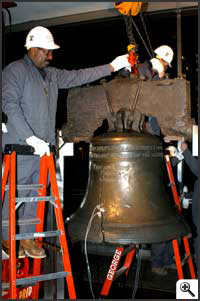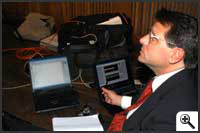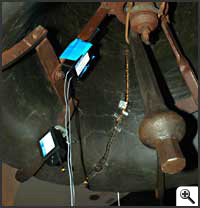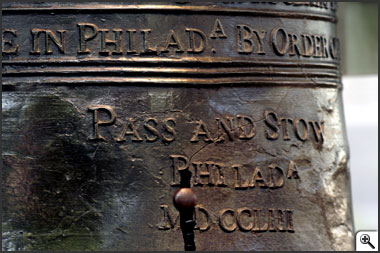|
 On March 14, 2003, under the watchful eyes of curators, conservators, surveyors, and engineers, a team of riggers deftly lifted the fragile Liberty Bell off of the supports on which it has been resting for a quarter century and confirmed the Bell could safely move into its new home. On March 14, 2003, under the watchful eyes of curators, conservators, surveyors, and engineers, a team of riggers deftly lifted the fragile Liberty Bell off of the supports on which it has been resting for a quarter century and confirmed the Bell could safely move into its new home.
The assembled experts were particularly concerned about a hairline fracture that extends from the main crack to the rear of the Bell—if the hairline fracture split, so would the icon.
 Steve Arms, president of MicroStrain, Inc.tracked movements of the metal along the crack using tiny, wireless sensors he developed as part of the NSF Small Business Innovation Research program. The devices are extremely sensitive, able to detect motion as small as 1/100th the width of a human hair. Steve Arms, president of MicroStrain, Inc.tracked movements of the metal along the crack using tiny, wireless sensors he developed as part of the NSF Small Business Innovation Research program. The devices are extremely sensitive, able to detect motion as small as 1/100th the width of a human hair.
 The researchers used custom attachments to place two sensors, originally developed for the semiconductor industry, on the metal around the Bell's main crack. One sensor monitored stresses that could widen the crack, while another monitored stresses from shearing motions. Engineers and conservators believed that stresses along the main crack would warn of dangers that could spread to the hairline fracture. The team also hung a third sensor inside the Bell to monitor potentially jarring rocking motions. The researchers used custom attachments to place two sensors, originally developed for the semiconductor industry, on the metal around the Bell's main crack. One sensor monitored stresses that could widen the crack, while another monitored stresses from shearing motions. Engineers and conservators believed that stresses along the main crack would warn of dangers that could spread to the hairline fracture. The team also hung a third sensor inside the Bell to monitor potentially jarring rocking motions.
The Bell surface is extremely sensitive to both scratching and chemical damage, so the team could not use glues or directly touch metal to metal. Ultimately, Andrew Lins, chief conservator of the Philadelphia Museum of Art, worked with MicroStrain’s Steven Mundell to carefully clamp the devices to the Bell, inserting a special paper where the sensors would otherwise touch, and potentially mar, the surface.

Fortunately, the sensors detected no motions greater than several millionths of a meter, tiny movements that do not seem to stress the Bell.
To view the original NSF press release on the Liberty Bell test move, please see:
http://www.nsf.gov/news/news_summ.jsp?cntn_id=108290
** Photo Credits:
-- Curt Suplee, National Science Foundation
-- Peter West, National Science Foundation
|










